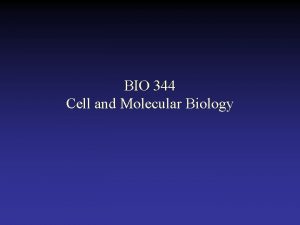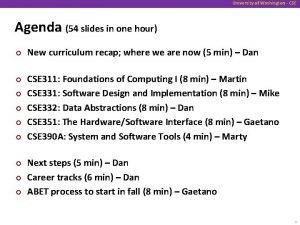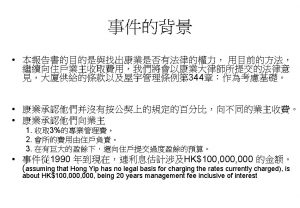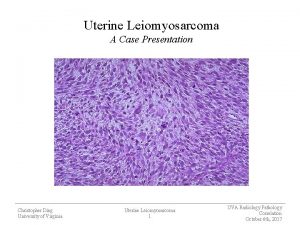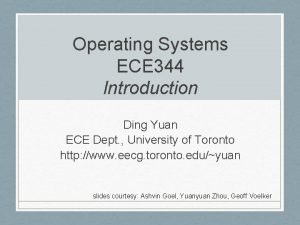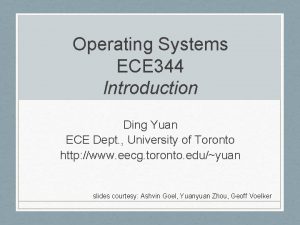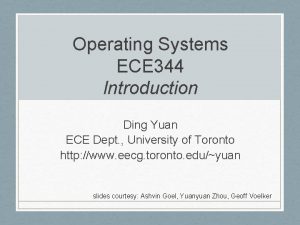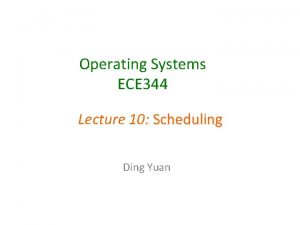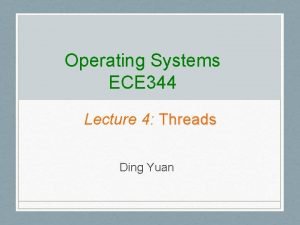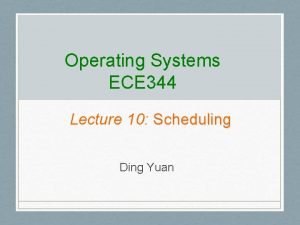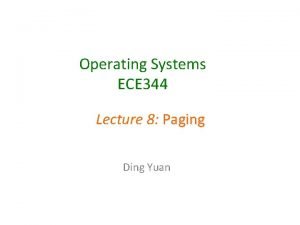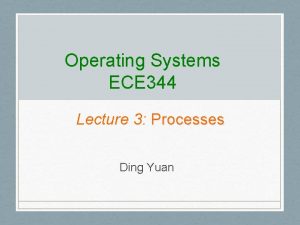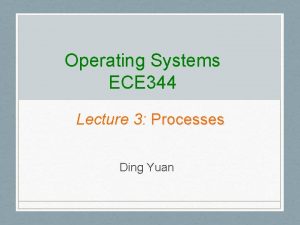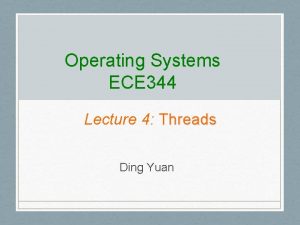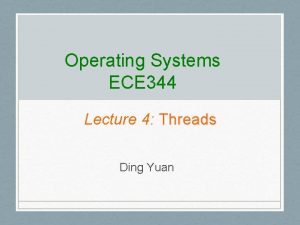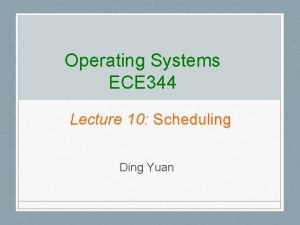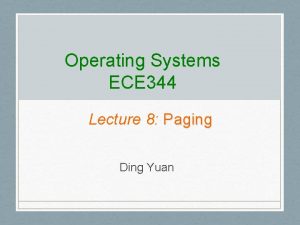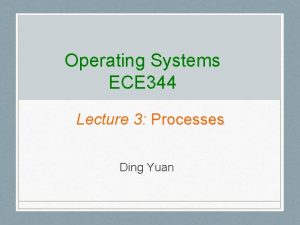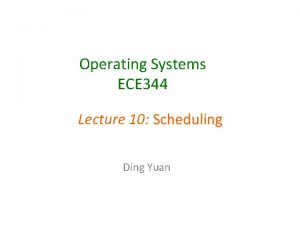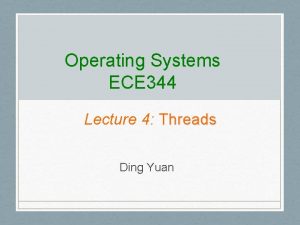Operating Systems ECE 344 Lecture 11 SSD Ding

















- Slides: 17

Operating Systems ECE 344 Lecture 11: SSD Ding Yuan © 2016 -2020 DING YUAN ALL RIGHTS RESERVED

Fundamental Limitation with HD � Mechanical � Cannot be made too fast � Latency in milliseconds © 2016 -2020 DING YUAN ALL RIGHTS RESERVED

Solid-State Drive (SSD) � Nonvolatile memory � This gives the device the “solid-state” name � Most common media: NAND Flash memory (Floating -gate transistors) © 2016 -2020 DING YUAN ALL RIGHTS RESERVED

SSD � Intel 520 Cherryville (2013) • Samsung 850 (2015) � Capacity: • Capacity: 1 TB 240 GB � Compare � Sequential � Compare to HD: TB R/W: 550/520 MB/s • Sequential R/W: 540/520 MB/s to HD: 122 MB/s � Latency � Read: 0. 04 ms � Write: 0. 2 ms � Compare to HD: tens of ms • $0. 5/GB ($0. 2/GB today) � $1/GB � Compare to HD: 0. 06/GB © 2016 -2020 DING YUAN ALL RIGHTS RESERVED

2020: Intel Optane � Latency: � DRAM: 94 -305 ns 81 ns � Available as DIMM (loaded into RAM slot) © 2016 -2020 DING YUAN ALL RIGHTS RESERVED

Limitations of SSD � Random write performance � For write, need to first erase a large of pages (32 -64 pages), and reprogram � Burnout � Each cell has limited erase/program cycles � Range from 1, 000 – 100, 000 writes © 2016 -2020 DING YUAN ALL RIGHTS RESERVED

How do SSD’s characteristics impact FS design? � Characteristics of SSD � No mechanical components --- data location won’t make difference • Optimizations on data location are no longer useful � Random write performance is BAD • Avoid random writes! � Limited “write” cycles for each cell • Spread the writes across the entire SSD © 2016 -2020 DING YUAN ALL RIGHTS RESERVED

© 2016 -2020 DING YUAN ALL RIGHTS RESERVED

Log-structured File System � New physical layout � Logical organization remains the same, i. e. , inode � Motivations � I/O traffic dominated by writes � Reads are cached by memory � Sequential access is faster than random access on H. D. © 2016 -2020 DING YUAN ALL RIGHTS RESERVED

Core Ideas � Treat hard drive like a log � Append only � No in-place update � Buffer � What multiple small writes into a single large write about read? Who cares, cached anyway © 2016 -2020 DING YUAN ALL RIGHTS RESERVED

Unix Inodes � � Unix inodes implement an indexed structure for files � Each file or directory has one inode � Also store metadata info (protection, timestamps, length, ref count…) Each inode contains 15 block pointers � � First 12 are direct blocks (e. g. , 4 KB blocks) Then single, double, and triple indirect (Metadata) 0 1 12 13 14 … … (1) (2) (3) … … © 2016 -2020 DING YUAN ALL RIGHTS RESERVED

Example: read /var/log/syslog inode 2: / inode 3512: /var … usr 2783 var 3512. . log 5193 lib 5728. . inode 5193: /var/log inode 6264: /var/log/syslog 6264 dmesg 2832. . © 2016 -2020 DING YUAN ALL RIGHTS RESERVED data content (first 4 KB). . data content (2 nd 4 KB). .

Example: create a file dir 1/file 1 � Assume dir 1 already exists inode 45: dir 1/ Before After inode 45: dir 1/ inode 86: dir 1/file 1 25 file 0 83. . 2 … … file 0 83 file 1 86. . . . 7 8 inode # disk addr 45 14 45 86 6 1 . . garbage disk addr. : 0 1 2 3 4 5 6 7 8 9 disk addr. : 0 1 2 © 2016 -2020 DING YUAN ALL RIGHTS RESERVED 3 4 5 6 7 8 9

Garbage Collection � Can quickly run out of disk space � Constantly collect garbage � But GC is very complicated and can cause significant perf. degradation (up to 40%) � Similar to GC pause in today’s runtimes (e. g. , JVM) Before GC segment disk addr. : 0 1 2 3 After GC segment 4 5 6 7 garbage 8 9 segment disk addr. : 0 in-use 1 2 3 free © 2016 -2020 DING YUAN ALL RIGHTS RESERVED segment 4 5 6 7 8 9

Checkpoint & Rollback � Very easy b/c there is no in-place update! � Each inode map is a snapshot! inode 45: dir 1/ Before After inode 86: dir 1/file 1 25 file 0 83. . 2 … … file 0 83 file 1 86. . . . 7 8 inode # disk addr 45 14 45 1 86 6 2 disk addr. : 0 1 3 4 5 6 7 8 9 1 2 © 2016 -2020 DING YUAN ALL RIGHTS RESERVED 3 4 . . 5 6 7 8 9

SSD: Desirable features from file systems � Characteristics of SSD � No mechanical components --- data location won’t make difference • Optimizations on data location are no longer useful � Random performance • Avoidwrite random writes! � On every a • GC iswrite, “free”!!! is BAD large segment needs to be reprogrammed anyway • Spread the writes across the entire SSD � Limited “write” cycles for each cell © 2016 -2020 DING YUAN ALL RIGHTS RESERVED

Log-structured File System on SSD � Many popular Flash File Systems are log-structured File System � Linux JFFS/JFFS 2/YAFFS/Log. FS… � Vendors implement log-structured FS in their firmware! © 2016 -2020 DING YUAN ALL RIGHTS RESERVED
 Ring christmas bells ding dong
Ring christmas bells ding dong Morning bells are ringing
Morning bells are ringing Operating system lecture notes
Operating system lecture notes 01:640:244 lecture notes - lecture 15: plat, idah, farad
01:640:244 lecture notes - lecture 15: plat, idah, farad Screen truepress 344
Screen truepress 344 Java skrip
Java skrip Swen 344
Swen 344 Biology 344
Biology 344 Nau bio 344
Nau bio 344 Ai 344
Ai 344 Photography merit badge pamphlet
Photography merit badge pamphlet Swen 344 rit
Swen 344 rit Swen 344
Swen 344 Swen 344
Swen 344 Cse 344
Cse 344 Bmo 344
Bmo 344 Christopher ding
Christopher ding Pooh-pooh theory tagalog
Pooh-pooh theory tagalog








